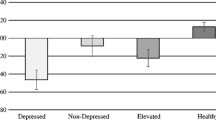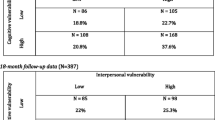Abstract
The purpose of this study was to investigate cognitive processes, which have been found in depressed adults, that may contribute to depression in adolescents. To this end, a modified version of Kelly's Role Construct Repertory Test was administered to 15 clinically depressed adolescents, 15 somewhat depressed adolescents, and 15 nondepressed adolescents, whose ages ranged from 13 to 16 years with the majority (75%) being female. Compared to the other groups, the clinically depressed group demonstrated lower self-esteem, greater pessimism about the future, more frequent polarized construing, increased interpersonal isolation, and a more external locus of control. Results are discussed in relation to findings from previous studies and recommendations are made for future research.
Similar content being viewed by others
References
American Psychiatric Association. (1987).Diagnostic and Statistical Manual of Mental Disorders-Revised. Washington, DC.
Angold, A. (1988). Childhood and adolescent depression: Research in clinical populations.Brit. J. Psychiat. 153: 476–492.
Asher, S. R., and Wheeler, V. A. (1985). Children's loneliness: A comparison of rejected and neglected peer status.J. Consult. Clin. Psychol. 53: 500–505.
Ashworth, C. M., Blackburn, I. M., and McPerson, F. M. (1982). The performance of depressed and manic patients on some repertory grid measures: A cross-sectional study.J. Med. Psychol. 55: 247–255.
Baron, P., and Perron, L. M. (1986). Sex differences in the Beck Depression Inventory scores of adolescents.J. Youth Adolesc. 15: 165–171.
Beck, A. T. (1967).Depression: Clinical, Experimental, and Theoretical Aspects. Harper & Row, New York.
Beck, A. T. (1970).Depression: Causes and Treatment. University of Pennsylvania Press, Philadelphia.
Beck, A. T. (1976).Cognitive Therapy and the Emotional Disorders. International Universities Press, New York.
Beck, A. T., Rush, A. J., Shaw, B. F., and Emery, G. (1979).Cognitive Therapy of Depression: A Treatment Manual. Guilford, New York.
Beck, A. T., Steer, R. A., and Garbin, M. G. (1988). Psychometric properties of the Beck Depression Inventory: Twenty-five years of evaluation.Clin Psychol. Rev. 8: 77–100.
Beck, A. T., Ward, C. H., Mendelson, M., Mock, J. E., and Erbaugh, J. (1961). An inventory for measuring depression.Arch. Gen. Psychiat. 4: 561–571.
Brightman, B. K. (1990). Adolescent depression and susceptibility to helplessness.J. Youth Adolesc. 19: 441–449.
Carlson, G. A., and Cantwell, D. P. (1979). A survey of depressive symptoms in a child and adolescent psychiatric population.J. Am. Acad. Child Psychiat. 18: 19–25.
Carlson, G. A., and Garber, J. (1986). Developmental issues in the classification of depression in children. In Rutter, M., Izard, C. E., and Read, P. B. (eds.),Depression in Young People. New York: Guilford.
Carlson, G. A., and Kashani, J. H. (1988). Phenomenology of major depression from childhood through adulthood: Analysis of three studies.Am. J. Psychiat. 145: 1222–1225.
Connelly, B., Johnston, D., Brown, D. R., Mackay, S., and Blackstock, E. G. (1993). The prevalence of depression in a high school population.Adolescence. 28: 149–158.
Ehrenberg, M., Cox, D. N., and Koopman, R. F. (1990). The prevalence of depression in high school students.Adolescence. 25: 905–912.
Erikson, E. (1968).Identity: Youth and Crisis. Norton, New York.
Goodyer, I. M. (1992). Depression in childhood and adolescence in Paykel, E. S. (ed.),Handbook of Affective Disorders. Guilford, New York.
Grossman, F. K., Beinashowitz, J., Anderson, L., Sakurai, M., Finnin, L., and Flaherty, M. (1992). Risk and resilience in young adolescents.J. Youth Adolesc. 21: 529–550.
Hodges, K. K., and Siegel, L. J. (1985). Depression in children and adolescents. In Beckham, E. E., and Leber, W. R. (eds.),Handbook of Depression: Treatment, Assessment, and Research. Dorsey, Homewood, IL.
Johnson, J. H., and McCutcheon, S. (1981). Correlates of adolescent pessimism: A study of the Beck Hopelessness Scale.J. Youth Adolesc. 10: 169–172.
Kashani, J. H., Carlson, G. A., Beck, N. C., Hoeper, E. W., Corcoran, C. M., McAllister, J. A., Fallahi, C., Rosenberg, T. K., and Reid, J. C. (1987). Depression, depressive symptoms, and depressed mood among a community sample of adolescents.Am. J. Psychiat. 144: 931–934.
Kashani, J. H., Reid, J. C., and Rosenberg, T. K. (1989). Levels of hopelessness in children and adolescents: A developmental perspective.J. Consult. Clin. Psychol. 57: 496–499.
Kazdin, A. E. (1988). Childhood depression. In Mash, E. J., and Terdal, L. G. (eds.),Behavioral Assessment of Childhood Disorders. Guilford, New York.
Kelly, G. A. (1955).The Psychology of Personal Constructs (Vols. 1 and 2). Norton, New York.
Kendall, D. P., Catwell, D. P., and Kazdin, A. E. (1989). Depression in children and adolescents: Assessment issues and recommendations.Cog. Ther. Res. 13: 109–146.
Kovacs, M. (1989). Affective disorders in children and adolescents.Am. Psychol. 44: 209–215.
Kovacs, M., and Beck, A. T. (1977). An empirical-clinical approach toward a definition of childhood depression. In Schulterbrandt, J. G., and Raskin, A. (eds.),Depression in Childhood: Diagnosis, Treatment, and Conceptual Models. Raven, New York.
Kuiper, N. A., and Derry, P. A. (1981). The self as a cognitive prototype: An application to person perception and depression. In Cantor, N., and Kihlstrom, J. E. (eds.),Personality, Cognition, and Social Interaction. Erlbaum, Hillsdale, NJ.
Landfield, A. W. (1976). A personal construct approach to suicidal behavior. In Slater, P. (ed.),Explorations of Intrapersonal Space. Wiley, New York.
Lempers, J. D., and Clark-Lempers, D. S. (1992). Young, middle, and late adolescents: Comparisons of the functional importance of five significant relationships.J. Youth Adolesc. 21: 53–96.
Lester, D. (1989). Locus of control, depression and suicidal ideation.Percept. Motor Skills. 69: 1102–1104.
Levitt, E. E., Lubin, B., and Brooks, J. M. (1983).Depression: Concepts, Controversies, and Some New Facts. Erlbaum. Hillsdale, NJ.
Luther, S. S. (1991). Vulnerability and resilience: A study of high-risk adolescents.Child Develop. 62: 600–616.
Matson, J. L. (1989).Treating Depression in Children and Adolescents. Pergamon, New York.
McCauley, E., Burke, P., Mitchell, J. R., and Moss, S. (1988). Cognitive attributes of depression in children and adolescents.J. Consult. Clin. Psychol. 56: 903–908.
Mitchell, M. G., and Rosenthal, D. M. (1992). Suicidal adolescents: Family dynamics and the effects of lethality and hopelessness.J. Youth Adolesc. 21: 23–33.
Neimeyer, R. A. (1983). Toward a personal construct conceptualization of depression and suicide.Death Educ. 7: 127–173.
Neimeyer, R. A., Klein, M. H., Gurman, A. S., and Greist, J. H. (1983). Cognitive structure and depressive symptomatology.Brit. J. Cog. Psychother. 1: 65–73.
Neuringer, C. (1961). Dichotomous evaluation in suicidal individuals.J. Consult Psychol. 25: 445–449.
Petersen, A. C., Sarigiani, P. A., and Kennedy, R. E. (1991). Adolescent depression: Why more girls?J. Youth Adolesc. 20: 247–271.
Rotheram-Borus, M. J., and Trautman, P. D. (1988).Hopelessness, Depression, and Suicidal Intent Among Adolescent Suicide Attempters. Report available from the American Academy of Child and adolescent Psychiatry, Box 60, 722 West 168th St., New York, NY 10032.
Rowe, D. (1978).The Experience of Depression. Wiley, New York.
Rutter, M. (1986). Depressive feelings, cognitions, and disorders: A research postscript. In Rutter, M., Izard, C. E., and Read, P. B. (eds.),Depression in Young People: Developmental and Clinical Perspectives. Guilford, New York.
Siegel, L. T., and Griffin, N. J. (1984). Correlates of depressive symptoms in adolescents.J. Youth Adolesc. 13: 475–487.
Space, L. G., and Cromwell, R. L. (1989). Personal constructs among depressed patients.J. Nerv. Mental Dis. 168: 150–158.
Strober, M., Green, J., and Carlson, G. A. (1981). Utility of the Beck Depression Inventory with psychiatrically hospitalized adolescents.J. Consult. Clin. Psychol. 49: 482–484.
Strober, M., and Werry, J. S. (1986). The assessment of depression in children and adolescents. In Sartorius, N., and Ban, T. A. (eds.),Assessment of Depression. Springer-Verlag, New York.
Teasdale, J., and Dent, J. (1987). Cognitive vulnerability to depression: An investigation of two hypotheses.Brit. J. Clin. Psychol. 26: 113–126.
Teri, L. (1982). The use of the Beck Depression Inventory with adolescents.J. Abnorm. Child Psychol. 10: 277–284.
Topol, P., and Reznikoff, M. (1982). Perceived peer and family relationships, hopelessness and locus of control as factors in adolescent suicide attempts.Suicide Life-Threaten. Behav. 12: 141–151.
Urberg, K. A. (1992). Locus of peer influence: Social crowd and best friend.J. Youth Adolesc. 21: 439–450.
Weisz, J. R., Weisz, B., Wasserman, A. A., and Rintoul, B. (1987). Control-related beliefs and depression among clinic-referred children and adolescents.J. Abnorm, Psychol. 96: 58–63.
Author information
Authors and Affiliations
Additional information
This study is based upon Wayne Hammond's master's thesis, which was supervised by David Romney.
Received MSc. from University of Calgary. Doctoral thesis will investigate substance abuse among the native Indians.
Received Ph.D. in Clinical Psychology from the Institute of Psychiatry (The Maudsley Hospital) in London, England. Research interests include identity formation in adolescents.
Rights and permissions
About this article
Cite this article
Hammond, W.A., Romney, D.M. Cognitive factors contributing to adolescent depression. J Youth Adolescence 24, 667–683 (1995). https://doi.org/10.1007/BF01536950
Received:
Accepted:
Issue Date:
DOI: https://doi.org/10.1007/BF01536950




